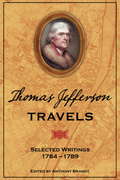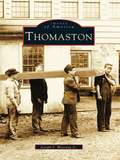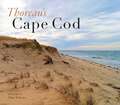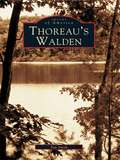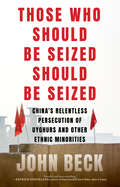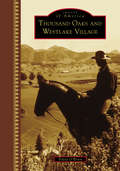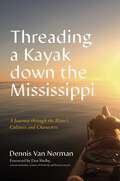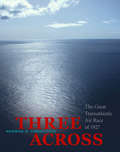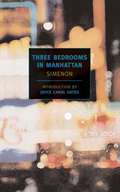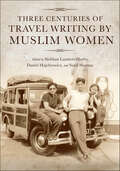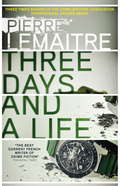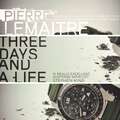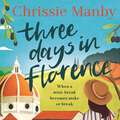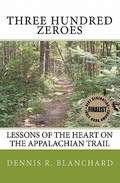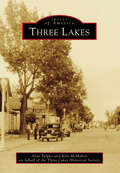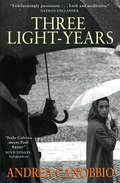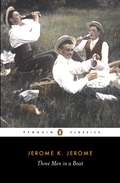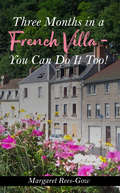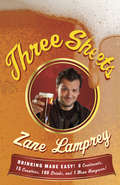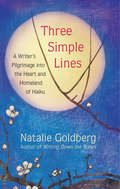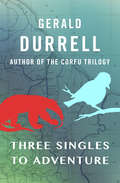- Table View
- List View
Thomas Jefferson Travels: Selected Writings, 1784-1789
by Anthony BrandtBrandt (editor, National Geographic books) explores a little-known aspect of Jefferson's body of work, using excerpts from Jefferson's voluminous travel diaries and personal correspondence to follow his journeys throughout Europe during his five-year residency in Paris. The writings give readers a new perspective on European life in the 18th century and on the beginnings of the French Revolution. Brandt provides an introduction and commentary throughout the selections. Annotation ©2006 Book News, Inc. , Portland, OR (booknews. com)
Thomaston (Images of America)
by Joseph F. Wassong Jr.Thomaston, a gateway to the Litchfield Hills and the Berkshires, is situated in the picturesque Naugauck River Valley. This town of Victorian charm grew as local industry developed. Today, it includes a population representing many occupations and nationalities and a mixture of urban and suburban culture. Thomaston reveals the history of this town and its people, including a nineteenth-century priest who is a candidate for sainthood in the Roman Catholic Church, the grandfather of a Nobel Prize-winning author, and a hero who was awarded the Medal of Honor for valor at Pearl Harbor. The first part of the book is designed as a guide for a walking tour of the downtown area.
Thor Heyerdahl, Viking Scientist
by Wyatt BlassingameMeet Thor Heyerdahl! As a young boy, he could not learn to swim. As a high school student, he opened a museum. As a man, he sailed Balsa wood and papyrus reed boats. He became a respected scientist, and a protector of oceans.
Thoreau's Cape Cod
by Dan TobyneBeginning in 1849, Henry David Thoreau made four walking tours of Cape Cod. Along the way he recorded his observations on the natural world as well as on the nature of the people he met. His resulting book has generally been considered his sunniest and lightest, filled with jokes, puns, and tall tales. Now photographer Dan Tobyne captures the essence of the Cape Cod Thoreau discovered. The combination of short excerpts and stunning imagery carries Thoreau&’s work to a new level, presenting it in both glowing words and pictures.
Thoreau's Walden
by Tim SmithWalden Pond is a sublime place of peace and spirituality. Writer and philosopher Henry David Thoreau built a one-room house in 1845 and lived on the shores of the pond for two years, two months, and two days. It is this "experiment in independent living" that draws millions of people to visit the pond and to pay homage to the man sometimes called the father of American conservation. Situated in woodland outside the town of Concord, the pond and the town itself also evoke history on a grand scale. The Revolutionary War and the literary revolution of the mid-nineteenth century both began in the area.Thoreau's Walden describes the beauty of this historical setting through the writings of Thoreau. The book uses many of his most captivating and inspiring quotations as a tribute to the man and his life, works, and philosophy. Beautiful images and descriptive historical writing combine to create a visual insight into the reasons why Thoreau lived at Walden and what he has to teach us about this most inspirational place. Thoreau's Walden also includes little-known facts about the writer and philosopher, including the stories behind his relationship with Ralph Waldo Emerson, his search for the perfect location for his experiment, and his many visitors, such as Nathaniel Hawthorne and the Alcott family.
Those Who Should Be Seized Should Be Seized: China's Relentless Persecution of Uyghurs and Other Ethnic Minorities
by John BeckA shocking, on-the-ground investigation of the Chinese government&’s brutal oppression of its Muslim citizens — the Uyghurs, ethnic Kazakhs, and others — from Xinjiang to the streets of New York and Washington, DC . . .Award-winning journalist John Beck recounts China's persecution of the predominantly Muslim minorities in Xinjiang and its relentless pursuit of the few who escaped beyond its borders. Through intertwined literary narratives combined with snippets of original source material, including official directives and speeches, he pieces together the individual stories of what consecutive American administrations have described as genocide. The narrative moves from China to Kazakhstan, Turkey and the US, incorporating the tensions, discrimination, and occasional violence that characterised life in Xinjiang for decades. But when Xi Jinping is appointed President in 2013, the creeping repression quickly escalates into a crackdown of unprecedented scope and severity.Beck follows 4 characters: a Kazakh writer and an Uyghur nurse who survived re-education camps before ultimately escaping abroad, a human rights advocate involved in securing their release, and an inadvertent exile spied on by Chinese authorities as his family back home was used as leverage against him.Through their stories, the book explores identity, dehumanization, and censorship, the force of literature in dark times, and an all-pervasive apparatus of repression able to exist within miles of the White House.John Beck lived in Istanbul for a number of years, where he was in close contact with the city's Uyghur diaspora and wrote on the crackdown and related issues for publications including Harper's and National Geographic. Some of that work forms the basis of this book along with further reporting from Almaty, Kazakhstan, Virginia, and New York.
Thousand Oaks and Westlake Village (Images of America)
by Tricia O’brienOnce upon a time, the Conejo Valley was primarily home to the Chumash Indians, oak trees, and animals. Eventually, ranches took over, cowboys made the valley their home, and the area served as a country retreat for the adventurous people of Los Angeles. The producers of numerous movies and television shows took advantage of the natural beauty that could not be duplicated on a soundstage. Hollywood stars found privacy. Soon, word spread about the tranquility and wonderful opportunities of the Conejo Valley, and the growth began. Thousand Oaks received a name and boundaries and became a city, Lake Sherwood expanded, Hidden Valley was no longer so hidden, and the birth of Westlake Village brought the city to the country.
Threading a Kayak down the Mississippi: A Journey through the River's Cultures and Characters
by Dennis Van NormanIn 2005, Dennis Van Norman climbed into a kayak for the first time to spend an afternoon &“Huck Finning&” down the Mississippi River with his son and grandson. Little did he know that what started as an innocent, eight-mile kayaking introduction would eventually become a passion—or an addiction. He spent thirteen years, from his sixties through his mid-seventies, kayaking the length of the Mississippi, bit by bit, traveling more than 2,500 river miles from northern Minnesota to the southern tip of Louisiana in a boat built for one.Threading a Kayak down the Mississippi is the story of how one traveler fully experienced and embraced the Mississippi River and its surroundings. In the vein of Jonathan Raban's Old Glory, Dennis's account casts light on the Mississippi River&’s history, geography, and sociology, but it is a book about more than the river itself—it&’s also about the individuals and characters living along the Mississippi&’s shores. From the local foods and music to the customs and history, each experience is sandwiched between moments of pure serenity and those of sheer terror. This is the story of a journey of discovery on the country&’s most celebrated waterway, and an exploration of the wonderment, joy, and fear that will inevitably grab hold of you when you&’re sitting alone in a fourteen-foot plastic boat on America&’s greatest river.
Three Across: The Great Transatlantic Air Race of 1927
by Norman H. FinkelsteinIt's 1927, and the air race is on! Three pilots compete to be the first to fly across the Atlantic. In the spring of that year, three airplanes were at Roosevelt Field on Long Island preparing for a historic journey--a nonstop flight between New York and Paris. Which plane would be first? Most predicted that the Columbia, with renowned test pilot Clarence Chamberlin at the controls, would lead the way. Another plane, the America, was also a favorite. Its crew of four was headed by an authentic American hero, Richard E. Byrd, the famed Arctic explorer. Little was known about the third plane, the Spirit of St. Louis, piloted by a young flier named Charles Lindbergh. Fame and immortality awaited the winner. Based on primary sources, Three Across chronicles the daring feats of these courageous adventurers and the aftermath of their flights. Includes source notes, author's note, bibliography, and index.
Three Bedrooms in Manhattan
by Georges SimenonAn actor, recently divorced, at loose ends in New York; a woman, no less lonely, perhaps even more desperate than the man: they meet by chance in an all-night diner and are drawn to each other on the spot. Roaming the city streets, hitting its late-night dives, dropping another coin into yet another jukebox, these two lost souls struggle to understand what it is that has brought them, almost in spite of themselves, together. They are driven—from moment to moment, from bedroom to bedroom—to improvise the most unexpected of love stories, a tale of suspense where risk alone offers salvation. Georges Simenon was the most popular and prolific of the twentieth century's great novelists. Three Bedrooms in Manhattan—closely based on the story of his own meeting with his second wife—is his most passionate and revealing work.
Three Book Sebald Set: The Emigrants, The Rings of Saturn, and Vertigo
by Michael Hulse W. G. SebaldThe masterworks of W. G. Sebald, now in gorgeous new covers by the famed designer Peter Mendelsund New Directions is delighted to announce beautiful new editions of these three classic Sebald novels, including his two greatest works, The Emigrants and The Rings of Saturn. All three novels are distinguished by their translations, every line of which Sebald himself made pitch-perfect, slaving to carry into English all his essential elements: the shadows, the lambent fallings-back, nineteenth-century Germanic undertones, tragic elegiac notes, and his unique, quiet wit.
Three Centuries of Travel Writing by Muslim Women
by Siobhan Lambert-Hurley, Daniel Majchrowicz and Sunil SharmaWhen thinking of intrepid travelers from past centuries, we don't usually put Muslim women at the top of the list. And yet, the stunning firsthand accounts in this collection completely upend preconceived notions of who was exploring the world. Editors Siobhan Lambert-Hurley, Daniel Majchrowicz, and Sunil Sharma recover, translate, annotate, and provide historical and cultural context for the 17th- to 20th-century writings of Muslim women travelers in ten different languages. Queens and captives, pilgrims and provocateurs, these women are diverse. Their connection to Islam is wide-ranging as well, from the devout to those who distanced themselves from religion. What unites these adventurers is a concern for other women they encounter, their willingness to record their experiences, and the constant thoughts they cast homeward even as they traveled a world that was not always prepared to welcome them.Perfect for readers interested in gender, Islam, travel writing, and global history, Three Centuries of Travel Writing by Muslim Women provides invaluable insight into how these daring women experienced the world—in their own voices.
Three Days and a Life
by Pierre LemaitreLONGLISTED FOR THE CWA INTERNATIONAL DAGGER 2018Antoine is twelve years old. His parents are divorced and he lives with his mother in Beauval, a small, backwater town surrounded by forests, where everyone knows everyone's business, and nothing much ever happens. But in the last days of 1999, a series of events unfolds, culminating in the shocking vanishing without trace of a young child. The adults of the town are at a loss to explain the disappearance, but for Antoine, it all begins with the violent death of his neighbour's dog. From that one brutal act, his fate and the fate of his neighbour's six year old son are bound forever.In the years following Rémi's disappearance, Antoine wrestles with the role his actions played. As a seemingly inescapable net begins to tighten, breaking free from the suffocating environs of Beauval becomes a gnawing obsession. But how far does he have to run, and how long will it take before his past catches up with him again?Translated from the French by Frank Wynne
Three Days and a Life
by Pierre LemaitreLONGLISTED FOR THE CWA INTERNATIONAL DAGGER 2018Antoine is twelve years old. His parents are divorced and he lives with his mother in Beauval, a small, backwater town surrounded by forests, where everyone knows everyone's business, and nothing much ever happens. But in the last days of 1999, a series of events unfolds, culminating in the shocking vanishing without trace of a young child. The adults of the town are at a loss to explain the disappearance, but for Antoine, it all begins with the violent death of his neighbour's dog. From that one brutal act, his fate and the fate of his neighbour's six year old son are bound forever.In the years following Rémi's disappearance, Antoine wrestles with the role his actions played. As a seemingly inescapable net begins to tighten, breaking free from the suffocating environs of Beauval becomes a gnawing obsession. But how far does he have to run, and how long will it take before his past catches up with him again?Translated from the French by Frank Wynne
Three Days and a Life
by Pierre LemaitreAntoine is twelve years old. His parents are divorced and he lives with his mother in Beauval, a small, backwater town surrounded by forests, where everyone knows everyone's business, and nothing much ever happens. But in the last days of 1999, a series of events unfolds, culminating in the shocking vanishing without trace of a young child. The adults of the town are at a loss to explain the disappearance, but for Antoine, it all begins with the violent death of his neighbour's dog. From that one brutal act, his fate and the fate of his neighbour's six year old son are bound forever.In the years following Rémi's disappearance, Antoine wrestles with the role his actions played. As a seemingly inescapable net begins to tighten, breaking free from the suffocating environs of Beauval becomes a gnawing obsession. But how far does he have to run, and how long will it take before his past catches up with him again?Translated from the French by Frank Wynne(P)2017 WF Howes Ltd
Three Days in Florence: perfect escapism with a holiday romance
by Chrissie ManbyThe new hilariously funny romance from the bestselling author of SEVEN SUNNY DAYS, perfect for fans of Melissa Hill, Jenny Colgan and Holly Martin'Manby's novels are made for holidays' Glamour*****When a mini-break becomes make or break...Kathy Courage has never visited the famous Italian city of Florence before, so she's thrilled when she and her boyfriend Neil are invited there for a wedding. Unfortunately, with Neil's constant complaining and his teenage children in tow, it's not exactly the romantic break Kathy was hoping for.But when a mix-up with her flights leaves Kathy stranded in the city, she decides to embrace the unexpected and stay on alone.What follows is a life-changing few days in the Tuscan sun, as Kathy begins to question the choices that have led her here. With the help of the colourful Innocenti family, who offer Kathy a place to stay, she gradually begins to realise that there's a much bigger world out there, if only she can be brave enough to explore it.Could Italy hold the answers to her future happiness? Or is Kathy destined to return to her old life?Praise for Chrissie Manby:'I've been a fan of Manby's writing for years and thoroughly enjoyed this' Daily Mail'Perfect, unputdownable summer adventures' Jenny Colgan'Nothing short of brilliant' Marie Clare'This sassy and addictive read will make you laugh - a lot!' Closer
Three Days in Florence: perfect escapism with a holiday romance
by Chrissie ManbyThe new hilariously funny romance from the bestselling author of SEVEN SUNNY DAYS, perfect for fans of Melissa Hill, Jenny Colgan and Holly Martin'Manby's novels are made for holidays' Glamour*****When a mini-break becomes make or break...Kathy Courage has never visited the famous Italian city of Florence before, so she's thrilled when she and her boyfriend Neil are invited there for a wedding. Unfortunately, with Neil's constant complaining and his teenage children in tow, it's not exactly the romantic break Kathy was hoping for.But when a mix-up with her flights leaves Kathy stranded in the city, she decides to embrace the unexpected and stay on alone.What follows is a life-changing few days in the Tuscan sun, as Kathy begins to question the choices that have led her here. With the help of the colourful Innocenti family, who offer Kathy a place to stay, she gradually begins to realise that there's a much bigger world out there, if only she can be brave enough to explore it.Could Italy hold the answers to her future happiness? Or is Kathy destined to return to her old life?Praise for Chrissie Manby:'I've been a fan of Manby's writing for years and thoroughly enjoyed this' Daily Mail'Perfect, unputdownable summer adventures' Jenny Colgan'Nothing short of brilliant' Marie Clare'This sassy and addictive read will make you laugh - a lot!' Closer(P) 2019 Hodder & Stoughton Ltd
Three Hundred Zeroes: Lessons Of The Heart On The Appalachian Trail
by Dennis R. BlanchardDennis Blanchard's promise to his brother haunted him for over forty years. Finally, when there were no more excuses, he set out on the Appalachian Trail to fulfill that promise. He learned that walking in the wilderness can reconnect one with a Norman Rockwell America that at times seems long lost and forgotten. The difficulties encountered walking over 2,200 miles are easily underestimated and trouble can begin long before setting a first step on the trail. Blanchard's introspective demonstrates that bears, rattlesnakes and challenging terrain may be far less formidable than some of life's more subtle dangers.
Three Lakes
by Alan Tulppo Three Lakes Historical Society Kyle McmahonNestled in the heart of Wisconsin's renowned Northwoods and surrounded by the world's largest inland chain of lakes, Three Lakes has developed into a premier resort and vacation destination while maintaining its small-town character. The pristine woodland trails and picturesque lakeside views that residents and visitors of today are accustomed to were not always here. Three Lakes was founded as a supply station for the massive logging operations of the late 1800s and early 1900s. Much of the area was barren of standing timber by the end of the first decade of the 20th century. The community reinvented itself as an agricultural center and as a vacation destination that played host to such notable individuals as Amelia Earhart, Bob Hope, and Pres. Dwight D. Eisenhower. The community has always shown pride in its schools, churches, and local organizations.
Three Light-Years
by Andrea CanobbioCecilia and Claudio are doctors are the same hospital. They eat lunch together almost every day; they talk, sometimes even share secrets. Each is enmeshed in a complicated, painful relationship that has technically ended but isn't really over: she is newly separated, with two small children; he's stuck in the apartment building where he grew up, where his senile mother, not to mention his ex-wife and her new family, all still live. Cecilia and Claudio are attracted to each other: magnetically, powerfully. But life has taught them to treat that attraction with suspicion. Then a chance encounter between Claudio and Cecilia's sister, Silvia, shifts the precarious balance of the relationship between the two colleagues. Claudio begins to recognize the damage caused by his wary stance toward everything around him. He has hidden a hunger for life and experience beneath a veneer of apathy, a mask that also conceals a deep well of anguish. And just when Cecilia comes to the realization that she loves Claudio and is ready to commit to a genuine relationship, fate steps in once again.
Three Men in a Boat: To Say Nothing Of The Dog
by Jerome K. JeromeA comic masterpiece that has never been out of print since it was first published in 1889, Jerome K. Jerome's Three Men in a Boat includes an introduction and notes by Jeremy Lewis in Penguin Classics.Martyrs to hypochondria and general seediness, J. and his friends George and Harris decide that a jaunt up the Thames would suit them to a 'T'. But when they set off, they can hardly predict the troubles that lie ahead with tow-ropes, unreliable weather forecasts and tins of pineapple chunks - not to mention the devastation left in the wake of J.'s small fox-terrier Montmorency. Three Men in a Boat was an instant success when it appeared in 1889, and, with its benign escapism, authorial discursions and wonderful evocation of the late-Victorian 'clerking classes', it hilariously captured the spirit of its age.In his introduction, Jeremy Lewis examines Jerome K. Jerome's life and times, and the changing world of Victorian England he depicts - from the rise of a new mass-culture of tabloids and bestselling novels to crazes for daytripping and bicycling.Jerome K. Jerome (1859-1927) was born in Walstall, Staffordshire, and educated at Marylebone Grammar School. He left school at fourteen to become a railway clerk, the first in a long line of jobs that included actor, teacher and journalist. His first book, On Stage and Off, a collection of humorous pieces about the theatre, was published in 1885, and was followed the year after with the more commercially-successful The Idle Thoughts of an Idle Fellow; but it was with Three Men in a Boat (1889) that Jerome achieved lasting fame. He later went on to become one of the founders of the humorous magazine, The Idler, and continued to write articles and plays. If you enjoyed Three Men in a Boat, you might like Stella Gibbons's Cold Comfort Farm, also available in Penguin Classics.
Three Months in a French Villa – You Can Do It Too!
by Margaret Rees GowThe mention of spending time in a French villa brings to mind so many intriguing thoughts - of white plaster-covered villa walls, grape vines climbing on a trellis outside a lace-curtained window, glasses of red wine being consumed on a sunny afternoon in a pretty garden, eating slices of bread smothered in lashings of olive butter. The images go on and on in one's mind and one is tempted to say "Damn it - I want to do it - I want to live in a French villa and experience life at its best - even if it can only be for the limit of three months". This is how we felt, so we started from scratch, knowing nothing of rural France, except that we wanted a villa in a centuries-old town. It was just the most wonderful three months of our lives. As we could not speak French, it was a difficulty, as no French person in Aubusson could speak English. But what fun it was trying to be understood!
Three Sheets: 6 Continents, 15 Countries, 190 Drinks, and 1 Mean Hangover!
by Zane LampreyMost people have a few drinks to relax after work. For Zane Lamprey, however, having a few (or a few too many) drinks is work. But he's not complaining. Zane has circled the globe knocking back an endless variety of booze while capturing his imbibing exploits for the cult-hit TV show Three Sheets. And now the Indiana Jones of alcohol consumption has gathered a round of his most amusing adventures, fascinating factoids, and tips for adventurous tipplers into this, the ultimate pub crawler's memoir. Join him as he ventures, glass in hand, to bull; Ireland, where whiskey was invented, drinking is a way of life, and beer is the best medicine bull; Tanzania, where the popular "bee brew," engortorogi, was accidentally discovered by a woman trying to poison her two-timing husband bull; Las Vegas, where the scary-to-look-at, tasty-to-sip, and impossible-to-finish-alone Witch Doctor is a better bet than the gaming tables, and a bacon martini is a savory way to wash down Sin City's famed $777 burger bull; Japan, where the celebrated sake is brewed like beer and once featured saliva as a secret ingredient bull; Poland, where vodka is the equivalent of America's apple pie (one of the most popular brands is infused with flakes of gold) and lovers of beer constitute an official political party Zane also sips champagne in the French region that gave the bubbly its name and heads to Tequila, Mexico to sample the infamous local spirit from the blue agave plant. He also bellies up to bars in Scotland, Jamaica, Argentina, New Zealand, Belgium, St. Martin, South Africa, and Taiwan. Each destination is a new adventure in libation. Packed with anecdotes, recipes and drinking games, and more hangover remedies than you can shake a swizzle stick at, Three Sheets makes for a delightfully intoxicating cocktail.
Three Simple Lines: A Writer’s Pilgrimage into the Heart and Homeland of Haiku
by Natalie GoldbergOne of the world&’s foremost writing teachers invites readers on a joyful journey into the reading and origins of haiku A haiku is three simple lines. But it is also, as Allen Ginsberg put it, three lines that &“make the mind leap.&” A good one, he said, lets the mind experience &“a small sensation of space which is nothing less than God.&” As many spiritual practices seek to do, the haiku&’s spare yet acute noticing of the immediate and often ordinary grounds the reader in the pure awareness of now. Natalie Goldberg is a delightfully companionable tour guide into this world. She highlights the history of the form, dating back to the seventeenth century; shows why masters such as Basho and Issa are so revered; discovers Chiyo-ni, an important woman haiku master; and provides insight into writing and reading haiku. A fellow seeker who travels to Japan to explore the birthplace of haiku, Goldberg revels in everything she encounters, including food and family, painting and fashion, frogs and ponds. She also experiences and allows readers to share in the spontaneous and profound moments of enlightenment and awakening that haiku promises.
Three Singles to Adventure
by Gerald DurrellJourney to South America on a search for endangered species with the author of My Family and Other Animals. In 1950, Gerald Durrell set off for British Guiana (now Guyana) to collect native wildlife and bring it back to his Jersey Wildlife Preservation Trust on the island of Jersey in the English Channel. On his journey, Durrell experienced all kinds of adventures: some amusing, some thrilling, and some extremely irritating. He traveled up the Essequibo River into the lush tropical forests and trekked across a landscape teeming with life and color. He encountered the sakiwinki monkey and the sloth with curiously green fur, heard the horrifying sounds of rampaging piranhas, and learned how to lasso a galloping anteater. He even met an ill-tempered anaconda and an overly affectionate bird. This remarkable memoir will take you into a wild place in another time, accompanied by the highly entertaining naturalist whose writings inspired popular Masterpiece series The Durrells in Corfu. This ebook features an illustrated biography of Gerald Durrell including rare photos from the author&’s estate.
